
Most customer relationship management (CRM) software and analytics tools only tell you how customers find your products or what they click on before deciding to buy. Everything in between is deemed irrelevant and, therefore, is invisible.
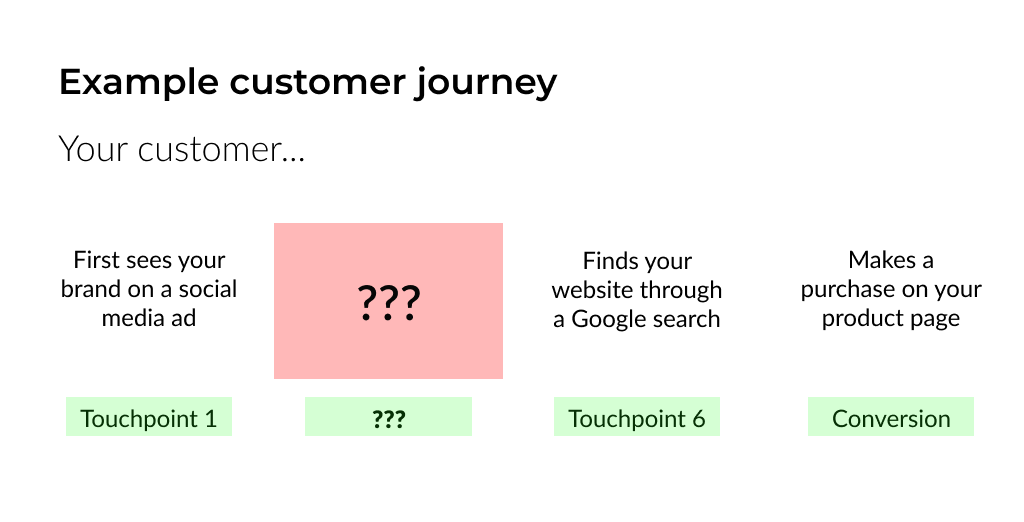
But that’s not enough data. In the simple customer journey illustrated above, the events you can see are:
- The customer found your product through a social media ad.
- The customer looked at your product page before purchasing.
The data implies investing in social media ads and improving your product pages are the only actions you need to take to increase conversions, but you’re missing the full picture.
You need to address everything that happened in between as well — and that’s where the multi-touch attribution (MTA) model comes in.
The MTA model tracks all the actions your customers take relating to your brand, such as looking at other product pages, reading your blog posts, and landing on your site for the fifth time after yet another Google search.
Use MTA to gain a clearer picture of what your customers see before buying. Having a comprehensive overview will help you make more accurate marketing decisions.
Table of contents
- What is multi-touch attribution?
- 3 Compelling benefits of a multi-touch attribution model
- 6 Types of multi-touch attribution models
- How to implement a multi-touch attribution model for your business
- 6 Multi-touch attribution tracking tools
What is multi-touch attribution?
Multi-touch attribution is a data tracking model that looks at all customer actions (i.e., marketing touchpoints) leading up to the final purchase. It then allots different weights to every touchpoint — also known as fractional credits — in each action.
For example, a customer may follow the path below before they decide to sign up:
- They discover your brand through a Facebook ad.
- They visit your website by clicking the Facebook ad.
- They see your brand again through an Instagram ad.
- They find your brand through organic channels (e.g., Google search).
- They see a paid ad for your product on Google.
- They find you organically again and finally sign up.
An MTA model is able to see and track these touchpoints across your customer’s journey to conversion. With all that data, you can then figure out how your customers find you and which channels they interact with the most.
Single-touch vs. multi-touch attribution
The biggest difference between the single-touch attribution and MTA models is, as its name implies, the former places full credit on one touchpoint that seems to have caused the sale (usually the first or last touchpoint).
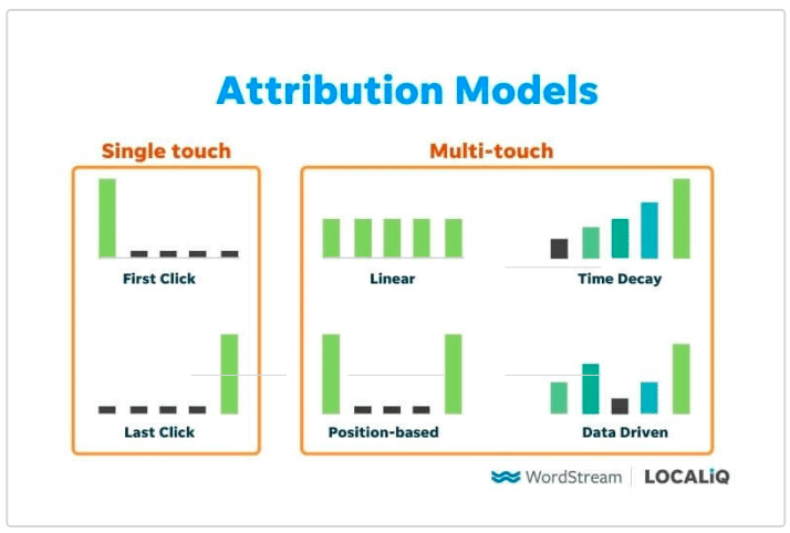
We recommend using one of the single-touch attribution models if your customer journey is simple; if your customers only find your products through Facebook ads, for instance, you don’t need the robust data tracking of MTA.
Single-touch attribution can be broken down into three types of models, which are:
- First-touch attribution – Tracks how your customer discovered your brand or product — that is, their first click. A company that wants to learn how customers find them will benefit most from first-touch attribution.
- Last-touch attribution – Tracks what your customers did before purchasing or signing up for your newsletter. Companies that need insight into where customers go before they buy can gain useful insights with last-touch attribution.
- Last-touch non-direct attribution – Tracks what customers did before they purchased, not including direct traffic (i.e., entering your website link in the URL bar). Companies that want to know which sites customers visit outside their brand’s website (e.g., a review site) should look into last-touch non-direct attribution.
Again though, single-touch attribution models are limited to straightforward buyer journeys; only use them if your marketing funnel is fairly basic or you need data on a specific part of your funnel.
3 Compelling benefits of a multi-touch attribution model
With MTA, you access a trove of data that reveals deeper insights into your customers, which of your efforts perform well, and which channels you should invest in.
1) Learn more about each marketing touchpoint
MTA assumes each marketing touchpoint contributes to a sale or conversion, so it assigns a fractional credit to every touchpoint along the customer journey.
By analyzing these credits, you can figure out which touchpoints have the biggest impact on the customer journey. That data will pinpoint which channels are the most effective at converting your target audience.
Let’s say you created a campaign on Facebook for a new product to draw more attention to your product. However, you frequently observe people taking the following journey:
- Discovery via organic search on Google
- Clicked on an affiliate link
- Saw your Facebook ad
- Went directly to your website by typing in your URL
- Saw an ad on Instagram
- Re-clicked on an affiliate link
In this data set, customers discovered your product through a Google search and an affiliate blog post before seeing your Facebook ad. That means your ad campaign wasn’t the driving force introducing your product to a wider audience — it merely reminded people who already know about your product that it exists.
Knowing that, you can 1) Change your ad so it focuses more on specific benefits rather than a broad introduction to your product, and; 2) Focus more on Google search ads and affiliate marketing campaigns.
Tweak your marketing campaigns based on when your customers usually interact with them.
2) Find out which campaigns and processes you can improve
Since the MTA model gives you data on each marketing touchpoint, you learn which are underperforming and which are successful.
It hones in on three key areas for improvement:
- Drop-off points – These are the moments your customers lose interest in your product or content and decide to abandon their journey instead of convert. Drop-off points indicate your content isn’t engaging enough to your existing target audience. Either you’re targeting the wrong audience or you need to improve how you communicate your unique selling point.
- Points of friction – Customer support touchpoints tell you where your customers regularly run into problems. Once you identify these points of friction, conduct customer interviews to find out what their specific obstacles are. Then, make improvements to smooth out the process.
- Areas of high interest – Touchpoints that consistently convert customers are likely attention-grabbing. So, if you discover an area of high interest, double down on it (i.e., optimize it) to convert even more customers.
Multi-touch attribution analysis provides actionable insights to refine your brand’s marketing efforts. Use that data to identify areas for improvement in your customer journey and tailor successful strategies to facilitate higher conversions at each stage.
3) Discover more about your target audience and most effective channels
The MTA model is highly specific, meaning you receive granular data about customer behavior and marketing campaign performance.
For example, if many of your customers interact with Instagram ads before making a purchase, it indicates that platform is popular among your consumer base, so you should develop your presence there. Or, if a lot of them reach your site through direct referrals, your growth is likely due to word-of-mouth marketing.
From there, you can determine which channels and messages resonate most with your target audience and tweak your messaging to personalize your campaigns.
6 Types of multi-touch attribution models
There are six types of MTA models, and before you implement MTA in your business, you need to determine which one best suits your current needs.
Each type of attribution model tracks different parts of the customer journey and assigns different values to each stage. The four important stages in the customer journey are:
- First touch – When someone first finds or interacts with your brand (e.g., they browse your website or read a blog post)
- Lead creation – When someone gives you their personal information (e.g., they sign up for your newsletter)
- Opportunity creation – When your lead begins to consider becoming a paying customer (e.g., they visit your website with the intention of purchasing, or sign up for a free plan)
- Last touch or customer close touch – When your potential customer becomes a paying customer (e.g., they click the checkout button and pay for the product)
Let’s review each model’s advantages and disadvantages to help you choose the best one for your brand.
1) Linear attribution
Linear attribution gives each stage in the customer journey equal credit. So, if your customer clicks on a Facebook ad today and then an affiliate link next week before converting, you’ll see they interacted with two channels. No one channel is more important than the other, so you’re forced to prioritize all of them in this model.
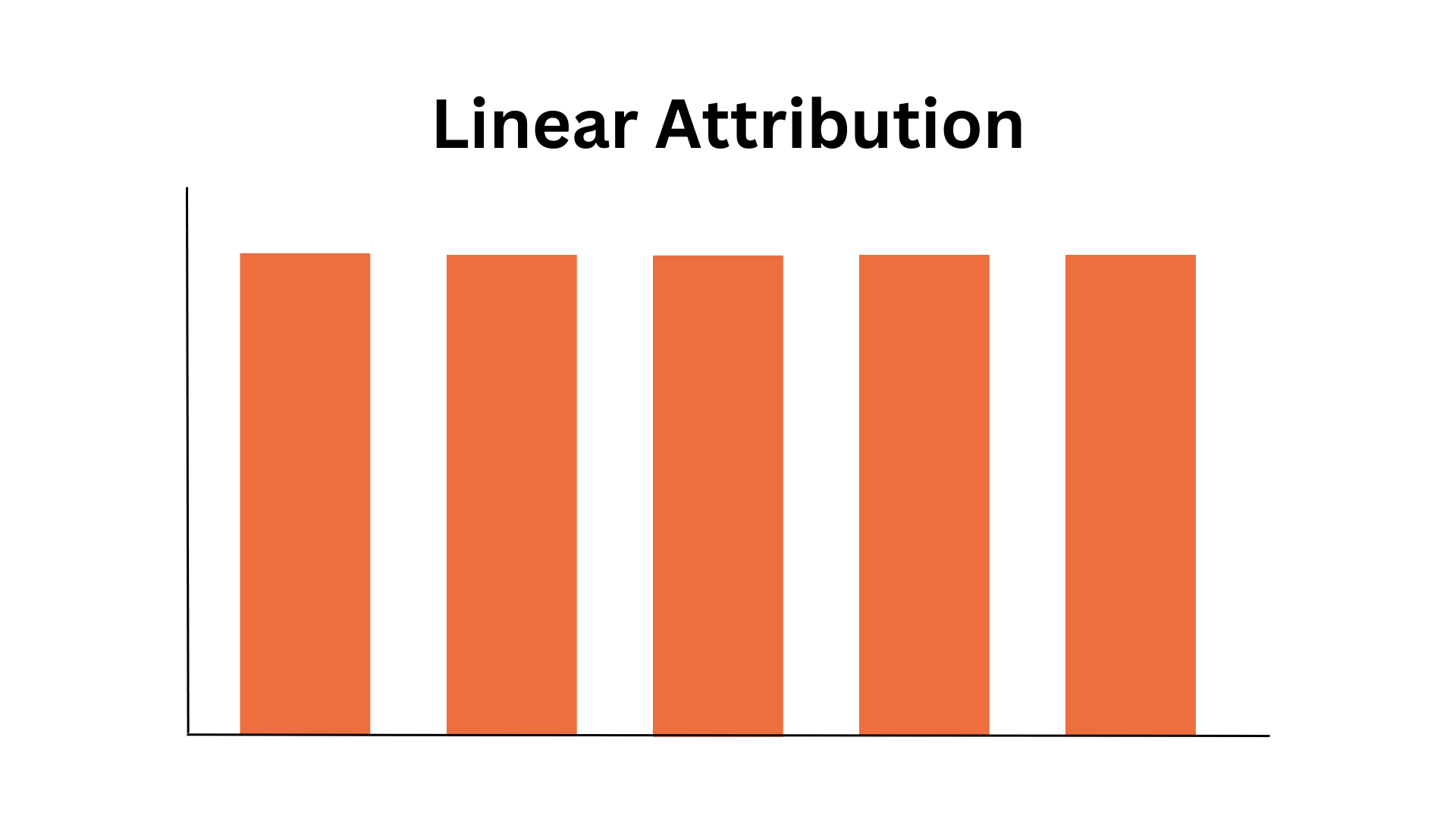
Advantages
The linear MTA model is the easiest to implement and understand since it simply shows which channels your customers interacted with before converting (or not).
This is most beneficial to businesses that are new to attribution, have few marketing touchpoints, and have a straightforward customer journey. It’s especially useful for companies that only need to know where their customers went before they converted.
Disadvantages
The downside is, this model ignores the greater importance some parts of the customer journey have compared to others. As a result, you can’t see which parts of the customer journey are more or less impactful.
For example, customers are more likely to convert after a product demo than after reading an informational article.
Since the model doesn’t give specific insights, you’d need to invest in all the marketing channels your customers interact with, rather than the specific, more effective ones.
2) Time decay
The time decay model assigns fractional credits to each touchpoint. The closer the touchpoint is to the conversion, the greater the credit it receives.
For example, if your customer clicked on a Facebook ad at the start of their journey and then clicked on an affiliate link right before becoming a paying customer, the affiliate link would gain a larger fractional credit.
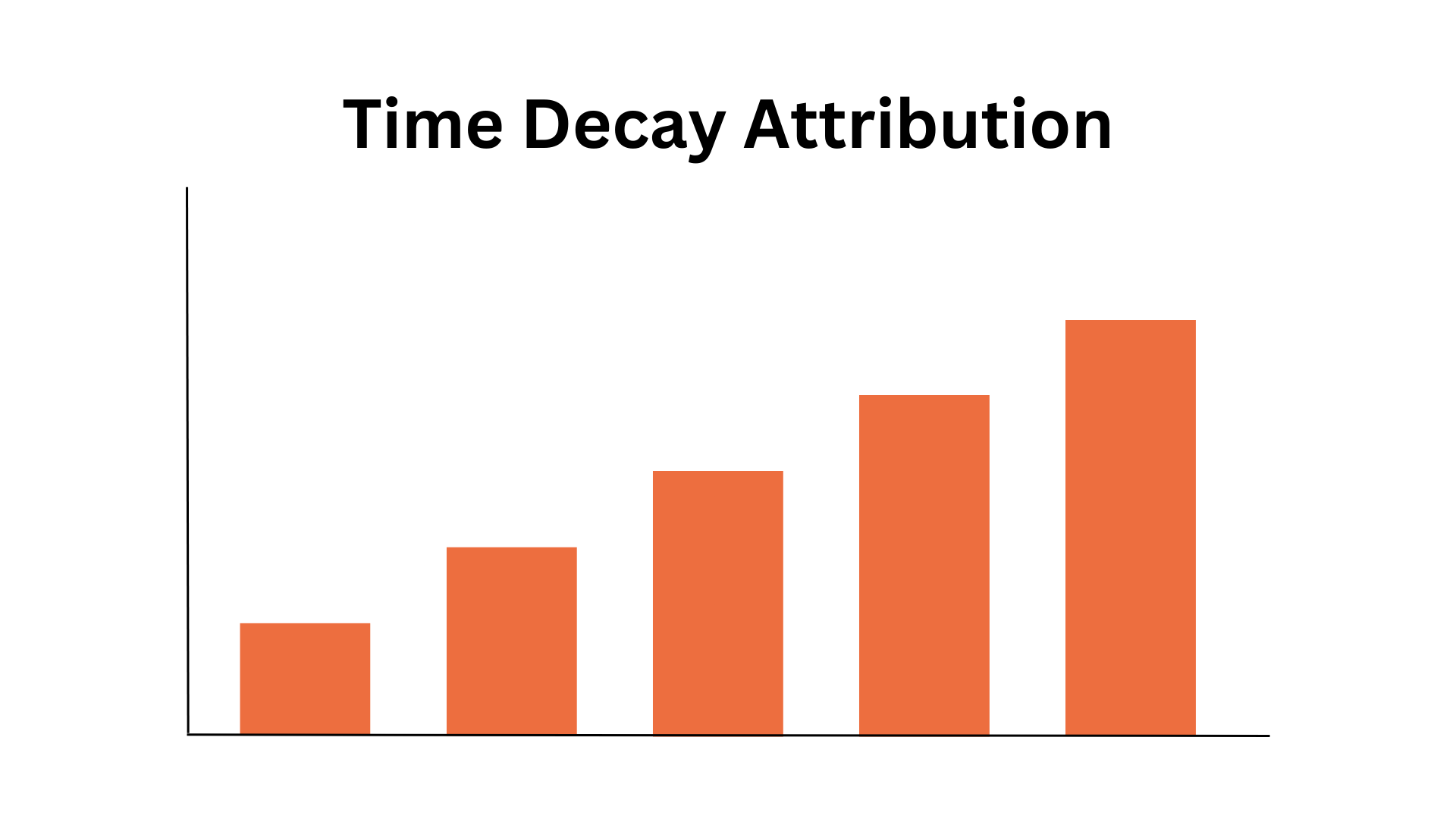
Advantages
The time decay model gives you a clear picture of your customers’ paths before they converted. You see where they started (smallest fractional credit), what they did after they found your brand (increasingly larger fractional credits), and what they clicked before they converted (biggest fractional credit).
That information can help determine which of your channels greatly impacted your customers’ decisions to convert. The model also provides data on how customers interact with your brand leading up to conversion, which you can analyze to figure out which channels and messages resonate most with them.
This model is best for companies with shorter customer journeys, like eCommerce stores or subscription services that often run promotions and discounts. Using the time decay model, you can see which channels were most effective over a specific period.
Disadvantages
On the flip side, this model gives little importance to the earlier stages of the customer journey. It assumes that if any earlier-stage marketing efforts were effective, customers would’ve converted earlier.
On top of that, it operates as if the customer journey is linear (in most cases, it isn’t).
Most customer journeys are now nonlinear. Let’s say you need a new tablet, so you decide to research them online and read reviews on a few options. Then, you see and click on a social media ad from Company X but don’t make a purchase. A few days later, you click on a display ad and read more about the tablet, still without buying — but you’re close.
The following day, you see a retargeting ad and decide this is it: You’re buying the tablet. But instead of following the ad, you type in the brand name, do a quick Google search, and purchase it on their DTC website.
In this nonlinear journey, each of the stages before the final purchase is just as important as the retargeting ad. This is why attributing credit to each touchpoint can be difficult.
3) U-shaped model
The U-shaped or bathtub model is a position-based attribution model that assigns larger fractional credits to the first and last touchpoints. It then divides the remaining credits equally among everything that happens in between.
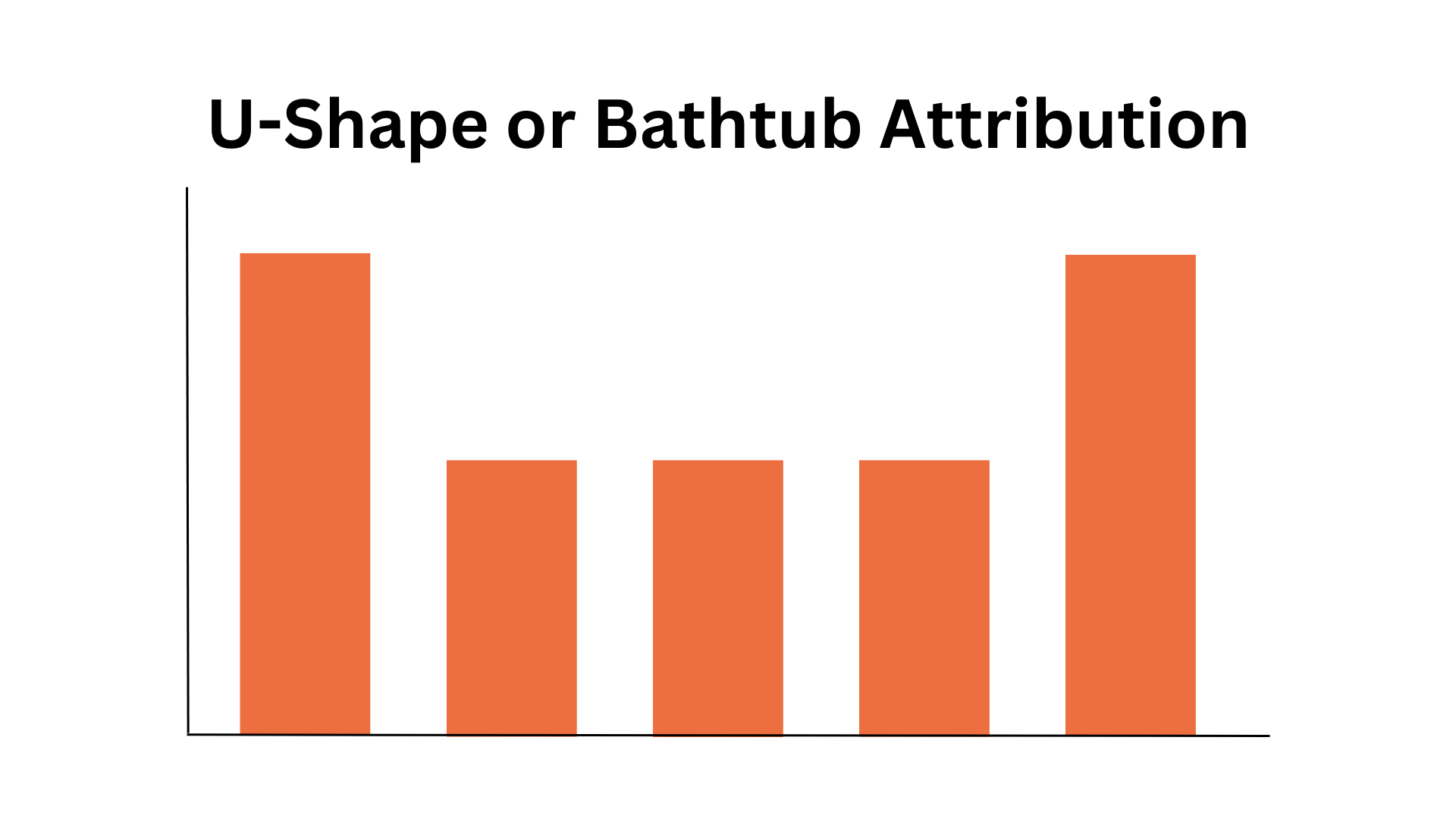
Advantages
This model is similar to the linear attribution model in that it’s easy to understand and implement. Compared to the linear attribution model, the U-shaped model paints a clearer picture of your customers’ journeys to finding and buying your product.
It also pinpoints which campaigns perform the best by telling you how most of your customers first found you and what they saw before deciding to convert.
This attribution model is best for companies that want to know how effective their top-of-funnel and bottom-of-funnel marketing campaigns and efforts are.
It’s also excellent for brands that need a simple idea of what their sales funnel looks like. Since credits are distributed equally among all the actions taken between the first and last touch, you gain a better understanding of your entire customer journey.
Disadvantages
The biggest disadvantage of the U-shaped attribution model is that it doesn’t account for time. Let’s say your customer saw a Facebook ad three months ago. Then today, they do some research and read reviews before clicking an affiliate link and finally making a purchase.
Despite the huge amount of time that passed between clicking on the Facebook ad and reading the reviews, the U-shaped model still assigns larger fractional credits to the Facebook ad and affiliate link. In the example though, the research and reviews are probably more important than the initial Facebook ad.
Additionally, this model doesn’t provide specific insights into what happens in between the first and last touch.
4) W-shaped model
The W-shaped or wave model is another position-based model that assigns bigger fractional credits to the first, middle, and last touchpoints — that is, your first touch, lead creation, and opportunity creation stages. Everything between those receives less weight.
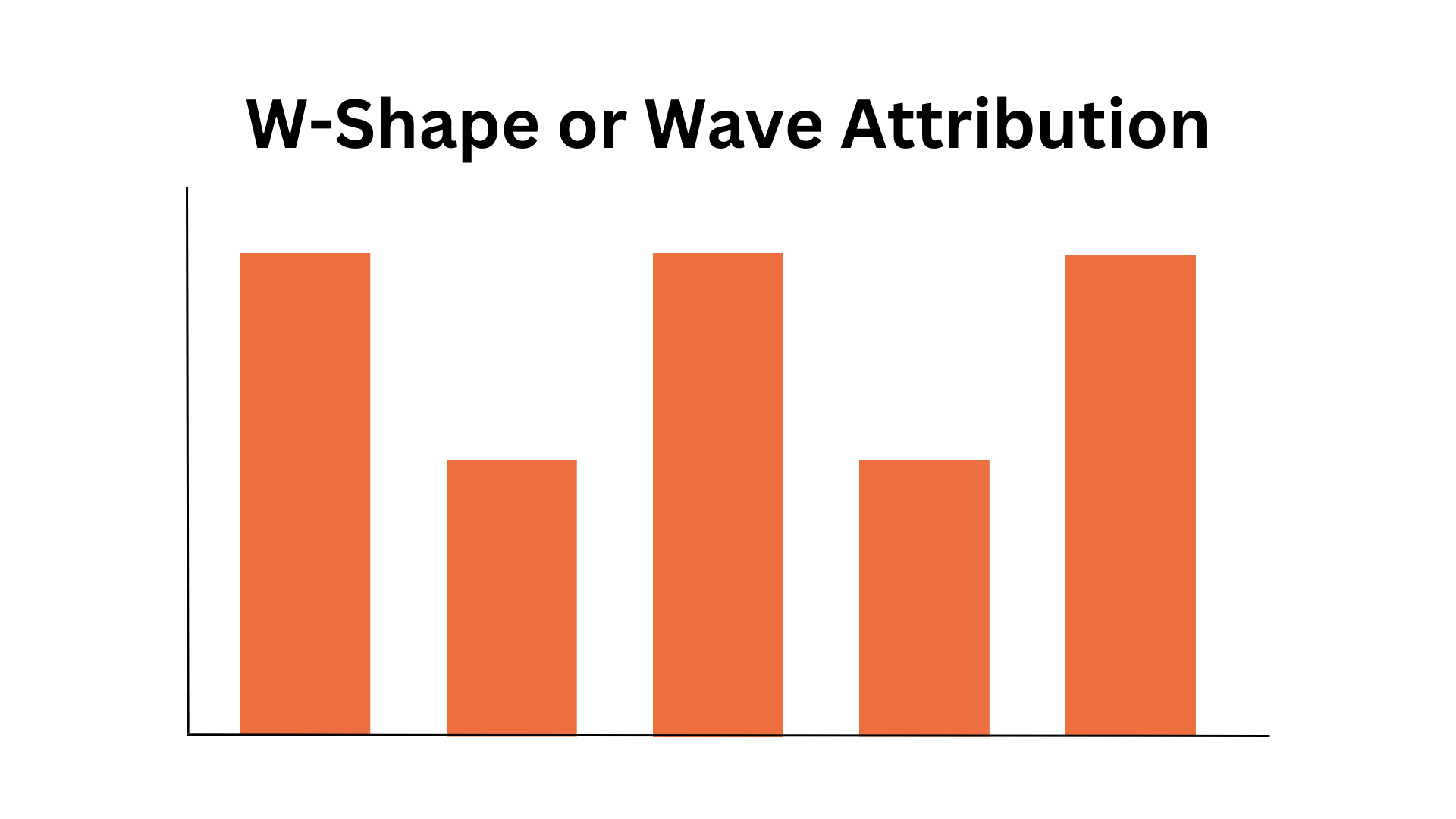
Advantages
Since the W-shaped attribution model assigns more weight to the start, middle, and end of the customer journey, you quickly grasp which channels your customers used to find your brand, research it, and then consider buying.
This model is also easy to set up and implement since it gives equal importance to everything that happens in between the first, middle, and last events in the customer journey.
It’s best for brands with uniform customer journeys. If your brand has various types of customers who take vastly different paths to conversion, the W-shaped model may not be right for you.
Disadvantages
This model assumes the middle touchpoint is just as important as the first and last — but what if your customer journey is short, with only three steps? And, similar to its U-shaped counterpart, the W-shaped model doesn’t take time passed into consideration either.
In the same vein, the W-shaped model places little value on events that occur in the middle of the “important” touchpoints. So, if your customer read reviews between the consideration and conversion steps, you wouldn’t see that.
5) Full path model
Also known as “algorithmic” or “Z-shaped”, the full-path model uses machine learning to tell you which events are the most influential. It does everything the W-shaped model does but tracks an extra stage in the customer journey — the last or customer close touch.

Advantages
This model provides the most complete view of your customer journey from start to finish, with no gaps. Using the full path model, you obtain a granular look at how each customer found your brand through to when they finally made a purchase.
Full path is especially useful for brands that sell products that need a lot of consideration — for example, a car or a new house — or that want to track a lot of marketing touchpoints.
Disadvantages
Because it’s so detailed, the full path model is also very difficult and costly to implement and maintain. It also requires a large volume of data to be effective; if you only have three or four touchpoints, you’re better off with another attribution model.
It’s also too much data for businesses whose customers make purchasing decisions quickly.
6) Custom models
If none of the preceding models seem like good fits, you may need to create your own. In a custom model, you decide which steps in the customer journey to assign more or less weight to and then build your attribution model based on that.
Advantages
Creating a custom model allows you to build it specifically for your business so it gives value to all the right components of the customer journey. For example, you can allot greater importance to what happens after discovery if that’s what you want to learn more about.
This approach works best for bigger businesses that have the resources and data specialists to set up a custom attribution system. It gathers granular information about the specific points in the journey that are most important to you.
Disadvantages
Unfortunately, custom models are difficult to set up and usually pricey. They’re also hard to maintain, especially for small teams.
How to implement a multi-touch attribution model for your business
Follow these six steps to incorporate an MTA model into your business.
1) Define your goals and choose an attribution model
Just like at the start of a marketing project, you need to set key performance indicators (KPIs) before introducing MTA into your business strategy.
Look into your organizational and your marketing goals to see if any align with why you want to use MTA.
Most companies want to know more about the customer journey so they can boost their sales and invest more in channels that convert well. In that case, your goal would be to increase the return on investment (ROI) of your marketing campaigns by $X.
2) Involve your team
Next, involve your teammates in the implementation process.
- Tell your marketing or data analysts about the new attribution model exploration
- Explain how the data can help to your marketing and other acquisition teams
- Communicate with your creative teams about this new marketing data initiative
- Adjust your budget to prepare for any necessary tools and discuss with finance
Make sure key stakeholders know what’s going on and what they need to do to gain the most from the new data.
3) Collect historical and site visitor data
Analyzing your current data helps you identify major touchpoints in the customer journey. These then determine which attribution model will work best for you.
You can collect historical data and data on your current site visitors using four methods:
- Use UTMs to track where your traffic is coming from.
- Read heatmaps to see what users do on your site.
- Review your analytics tool(s) to see how many website visits you get and from where.
- Look into customer interactions through social media, emails, and other communication channels.
4) Choose your attribution model
Choose an attribution model based on the touchpoints you’ve identified. For example, if you find you only have three marketing touchpoints and all of them have led to conversions at one point or another, then choose the linear model.
But, if you have 10 marketing touchpoints and your customers’ paths to conversion vary, then you might want to use the W-shaped or full path model to hone in on which touchpoints matter.
5) Implement the model and apply your insights
You can launch the MTA model on your own, but that takes a lot of time and resources. The better option is to use a reputable data tracking and organizing tool like Adobe Analytics (see a list of tools below).
After you’ve incorporated the model and collected some data, test its reliability: Act on some of the insights you uncover to see if they’re valuable and confirm that you’ve chosen the right MTA model.
6) Monitor and optimize your data dashboard
Lastly, continue to optimize the data you gather based on:
- How effective your insights are
- How many marketing touchpoints you have
Make sure to circle back to your original KPIs and see if you’re hitting your goals.
6 Multi-touch attribution tracking tools
Running an MTA model manually without software is tedious, expensive, and time-consuming. So, here are six tools you can use to speed up the process and capture more accurate data:
1) Google Analytics 4

Google Analytics is the best free multi-touch attribution tool out there. It’s easy to set up and has customizable data dashboards.
Key Features
- Customizable data dashboards that track what you want them to
- Connects directly with Google ads and other important tools
- Collects specific audience data like demographics (e.g., gender, age, education level)
Pricing
Google Analytics is free for anyone who has their own website and a Google account.
Update: An April 2023 announcement stated that GA4 will no longer support first-click, linear, time-decay, and position-based attribution models. Google Analytics is still a viable option for last-click attribution models. View Google Analytics alternatives here.
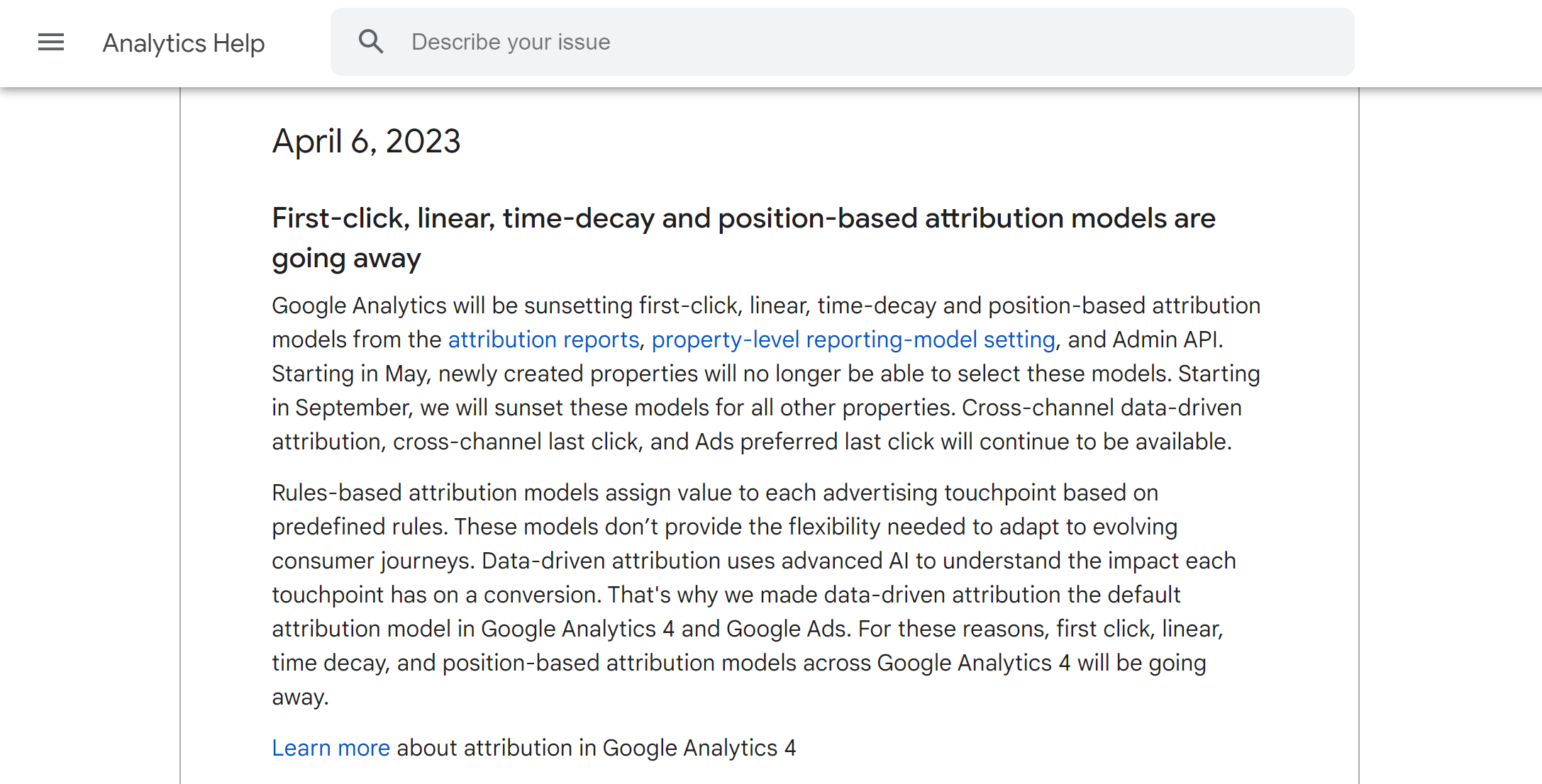
2) Ruler Analytics
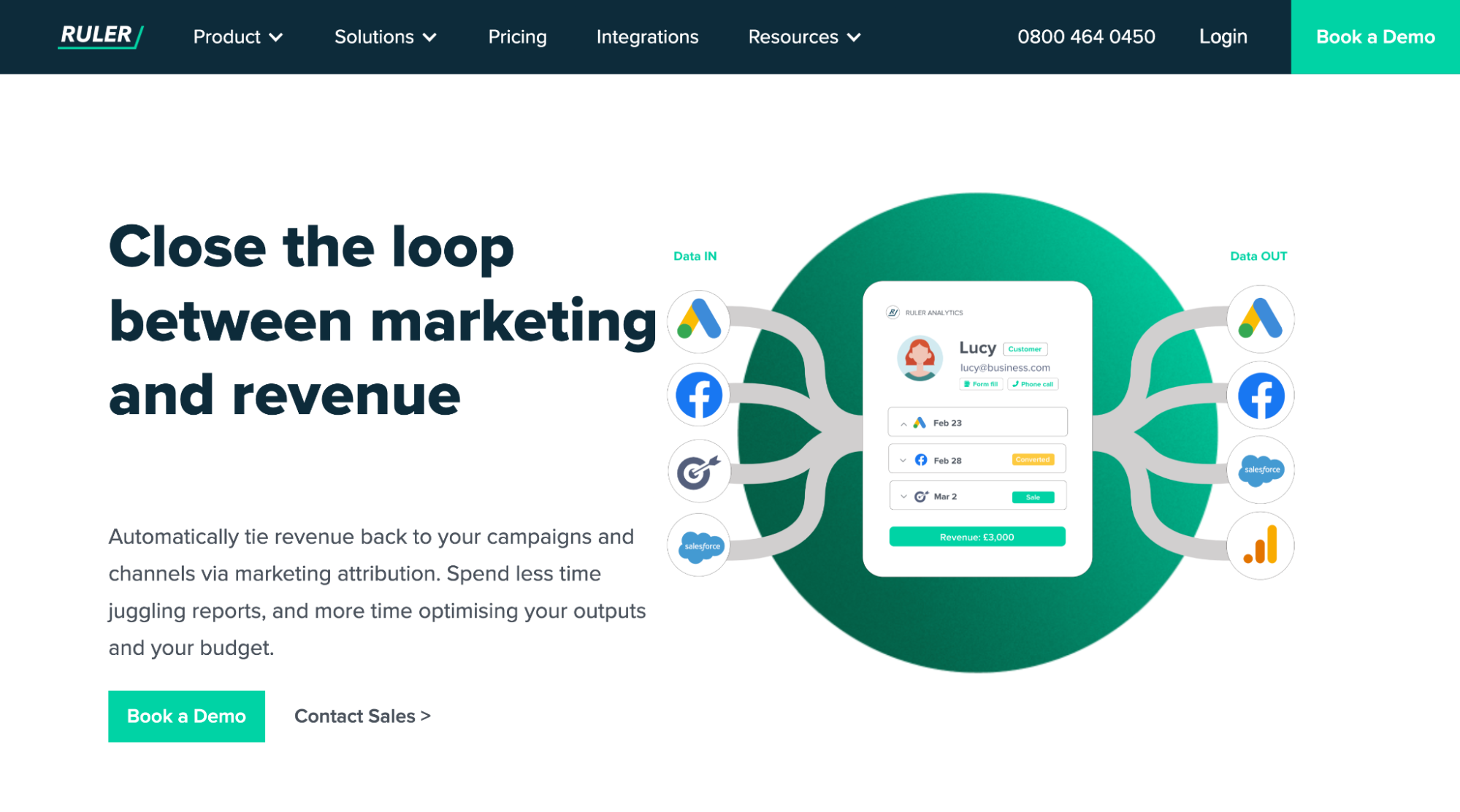
Ruler Analytics started out as a call tracking software but now doubles as a multi-touch marketing attribution tool.
Key Features
- Collects granular data on conversion actions (like filling out forms or answering calls) to give you valuable information you can use to guide your marketing decisions
- Integrates with most major tools and platforms
- Responsive customer support team
Pricing
Ruler Analytics has four plans, starting at £199, based on the size of your business.
3) HockeyStack
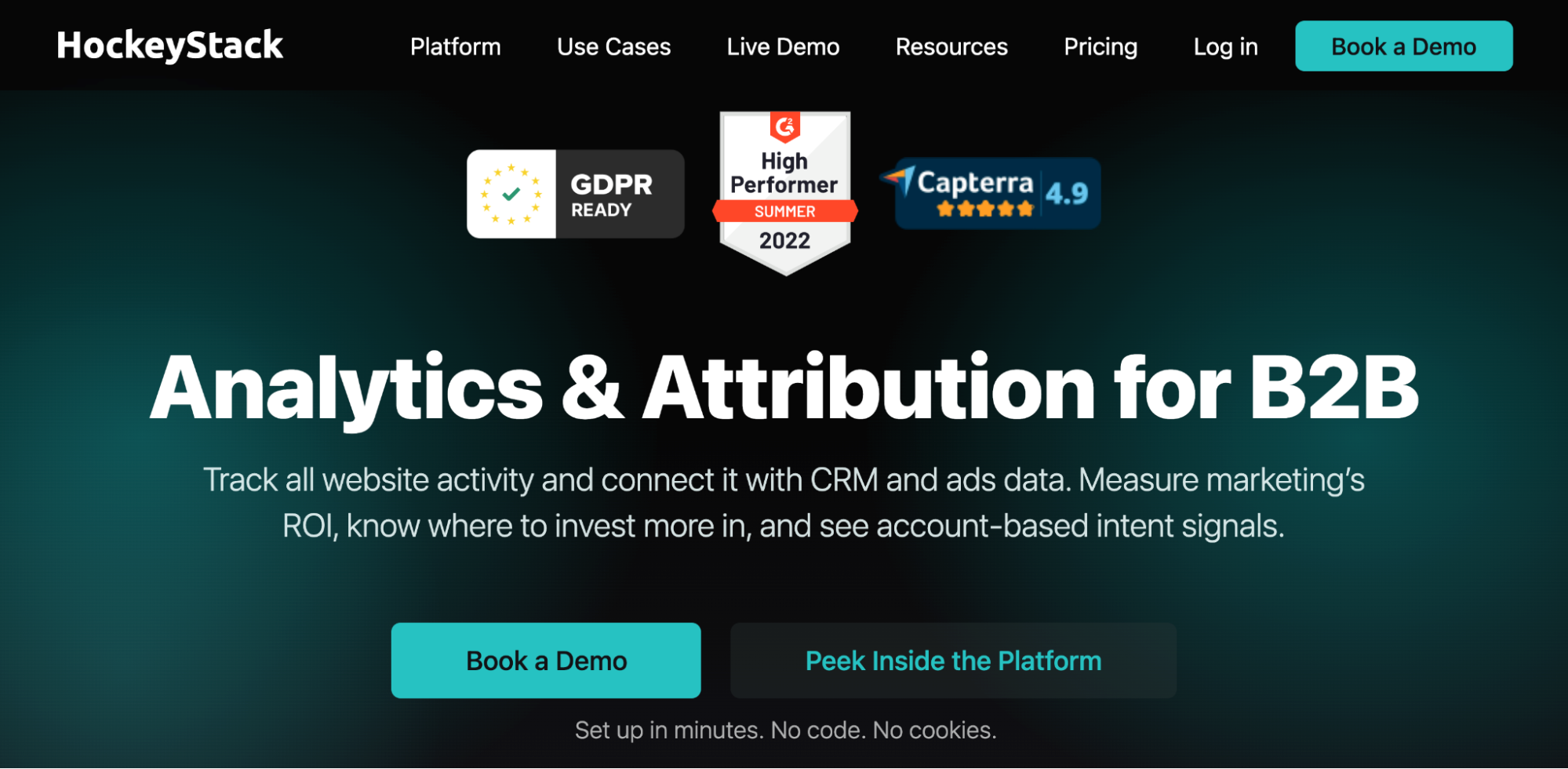
HockeyStack is a cookieless data analytics and attribution tool built specifically for B2B companies.
Key Features
- User-friendly software you can set up in minutes
- Non-cookie-based analytics that captures precise data on customer behavior and actions
- Automated goal-setting and insights so you can keep track of how you’re performing
Pricing
HockeyStack starts at $949 per month for up to 10,000 visitors and 10 seats. They also offer a 30-day refund policy, so you can get your money back if you’re unsatisfied.
4) Dreamdata
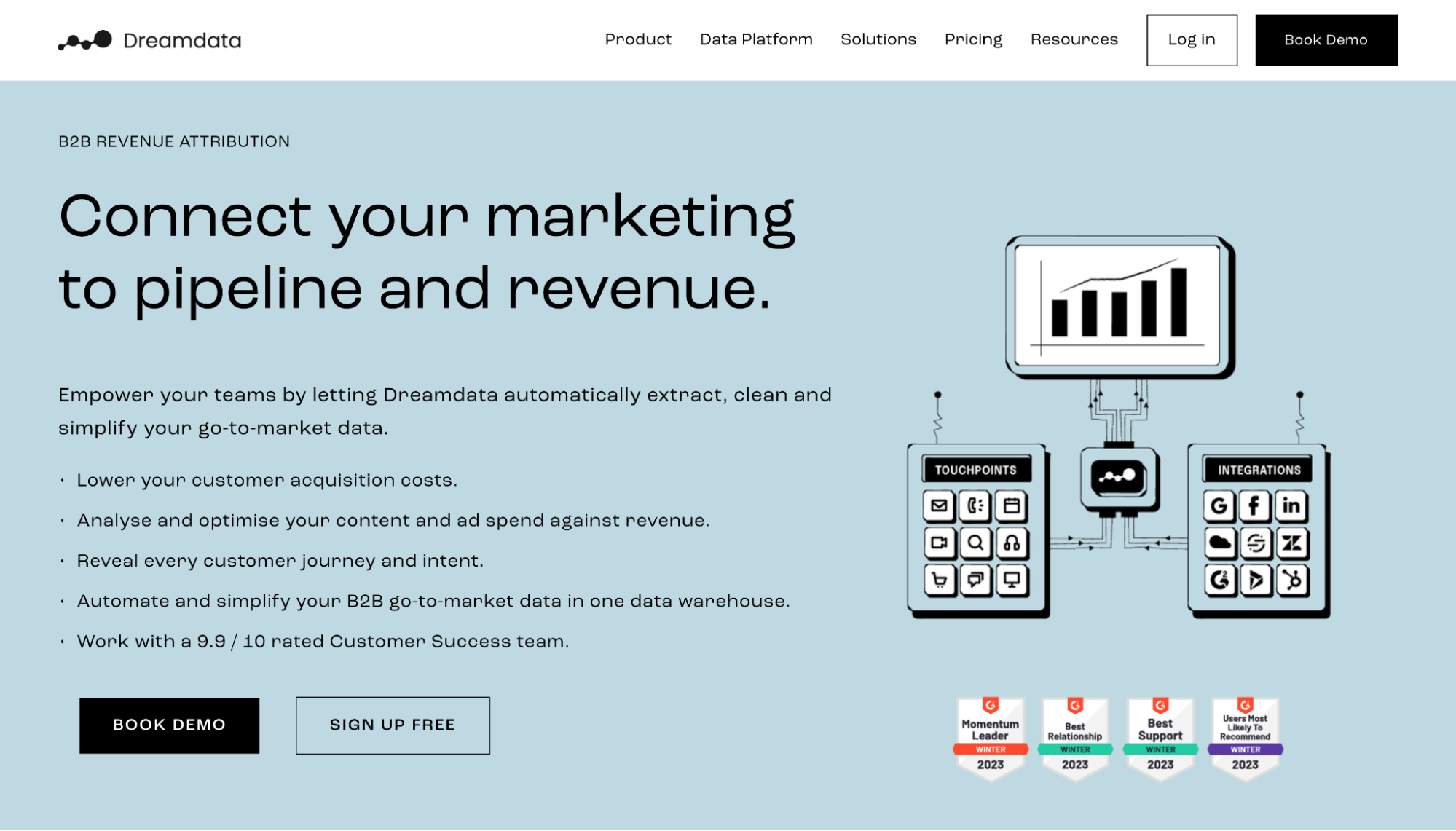
Another attribution tool for B2B companies, Dreamdata offers a free plan so you can try it before you buy.
Key Features
- Collects granular data on specific marketing campaigns that shows you where your customers drop in and off
- A dashboard that maps all customer touchpoints and detailed reports on revenue attribution
- Responsive customer support team
Pricing
Dreamdata has three pricing plans, one of which is a free account that can track up to 35,000 visitors per month.
5) Attribution
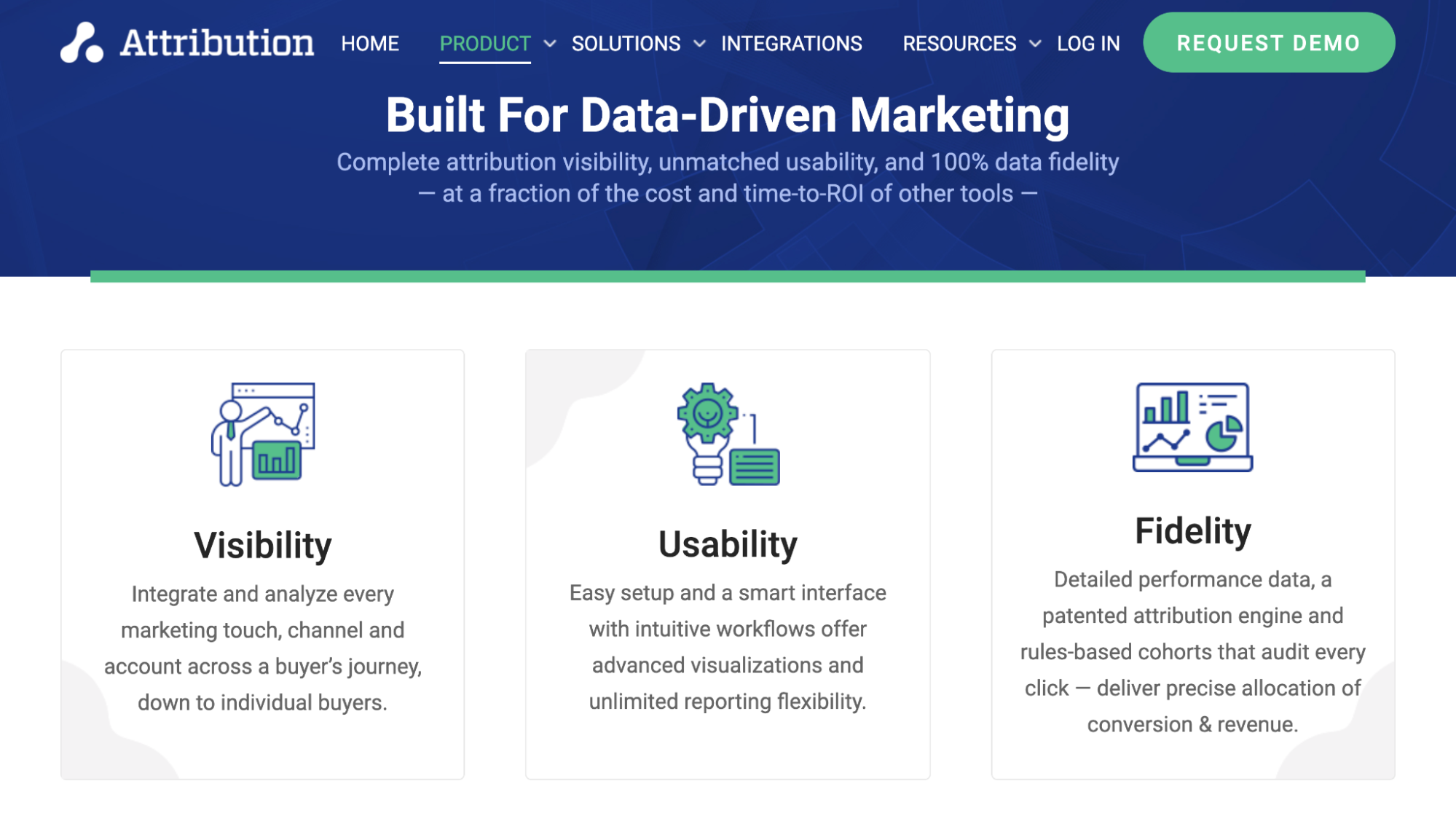
The aptly named Attribution is an enterprise-level attribution tool that uses the MTA model to collect and organize data. It’s great for both B2B and B2C marketers.
Key Features
- Robust, easy-to-use reporting dashboard
- Granular data for each campaign, including timestamps per click
- Integrations with top tools and platforms like Segment
Pricing
Attribution doesn’t display their pricing, so you have to book a demo to learn more about their tool.
6) Adobe Marketo Measure (formerly Bizible)

Adobe Marketo Measure reveals granular customer journey data so you can accurately track ROI per marketing campaign.
Key Features
- Multiple marketing attribution models to choose from
- Collects granular data so you can learn more about your customers and provides macro views to show you which campaigns perform the best
- Easy onboarding and responsive customer success team
Pricing
Adobe Marketo Measure offers four plans: Growth, Select, Prime, and Ultimate. But, since they offer custom pricing, you have to book a demo with them for an accurate estimate of how much it’ll cost your company.
Wrapping up — Understand the full customer journey with multi-touch attribution
Marketing attribution is an asset for making informed decisions about your existing campaigns and future plans. Analyzing the many and varied touchpoints throughout your customer journey will help you improve your weak points and enrich your strengths.
Don’t miss out on data — choose the best MTA model for your business methodology and start collecting information that’ll uncover rich insights into your target audience. As a result, you’ll learn the best channels to market on and be able to craft well-honed messages that convert.